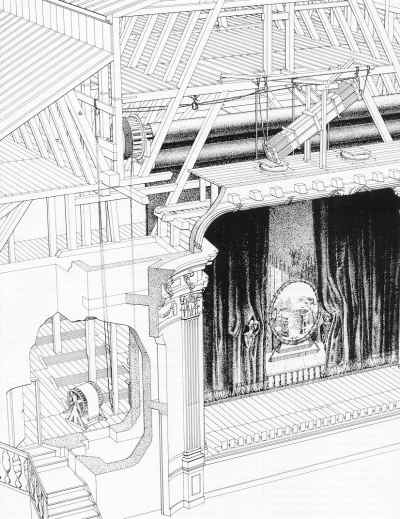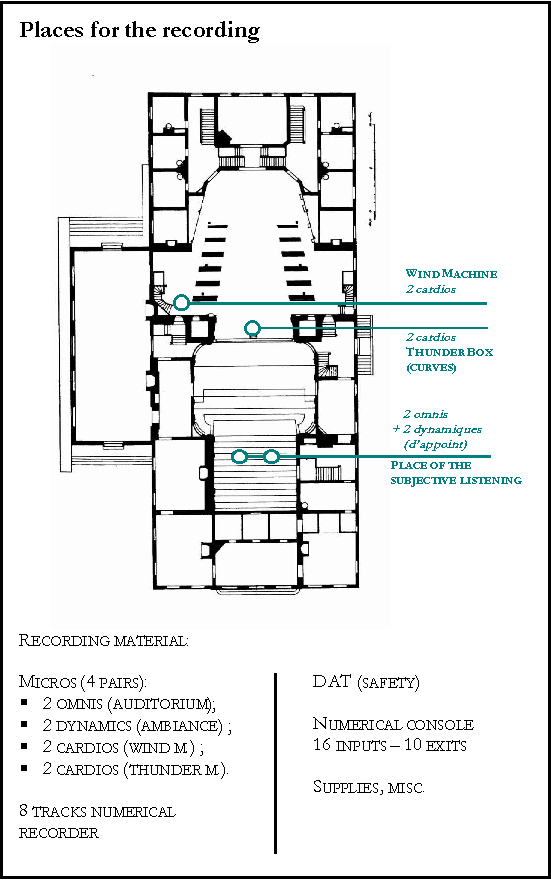| Forecasted
description of the project in April 2000 -
page 2/7 |
04/2000 |
The
wind and thunder machinery
at Drottningholm Slottsteater

From a drawing
by Gustaf Kull © 1974-1984
Putting
together the harmonica and the sounds of Drottningholm
The link between the
glassharmonica and Drottningholm Slottsteater became rapidly
obvious during the making of this project. Like the instrument,
the theatre is born of the XVIIIth century; and like
the theatre, it has also been "forgotten" for all of
the XIXth century. Its rediscovery during the XXth
century stems from a growing interest within our period for the
ancient repertory. One of the main composers who was interested
in the glassharmonica was J.-G. Naumann, composer of Gustave
III's court, who wrote twelve sonatas for it; Marie-Antoinette
played the Harmonica and most of the composers whose operas are
performed at Drottningholm have played or have written for the
glass harmonica.
The project Des Orages comes
from the desire to recreate this link by associating, in a
contemporary piece, the glassharmonica and two musical
instruments that have been found among machinery at
Drottningholms Slottsteater and put back into service:
- the thunder machinery or
"thunderbox" is a wood chest of three meters long,
suspended to a horizontal axis that crosses its centre,
containing round stones. By the action of cords, the box
seesaws, and stones roll to one side or the other. The
resonance of the box, amplified by the structure of the
auditorium, quite perfectly imitates the noise of the
thunder;
- the wind machine is made of
a wood cylinder, entailed by a crank, that rubs against
transverse cloth bands, producing a variable hiss well
conjuring the sound zephyrs and aquilons.
This machinery, which cannot
be removed from the stage, will provide the material for the
recorded electronics. The glassharmonica, as the featured
instrument, will therefore be played "directly" and
slightly amplified. As such, the aim of this project is not to
play any contemporary music at Drottningholm, but on the
contrary to "have Drottningholm heard" in a
contemporary piece. In this way, the work will make sound,
everywhere it will be played, these two instruments that have
remained confined during a hundred and twenty years in the
silent theatre.
In Des Orages (which
tells "the story" of a storm), the combination of the
glassharmonica and recordings of wind and thunder machines
creates a historical viewpoint. It concerns instruments dating
from the XVIIIth century, rejoined for a work that
directly makes reference to musical forms of XXIst
century. The tempest, as a musical form, appears
frequently as a dramatic episode in the opera of the XVIIIth
century - often enough to have these two resonant machines
attached to the visual stage machinery. But this gender
has equally existed, independently, in an instrumental form - as
for example in Vivaldi's Seasons (The Summer). This second
tradition, with a long history, is to be resumed and
reinterpreted here.
Des Orages adopts
a figuralistic viewpoint rather than realistic
that bears relation to the musical process that will be included
in the electronic part. The sounds do not fill a decorative
function but rather a dramatic function, and will be
incorporated into the written score. Therefore comes the
wish to employ not wind and thunder recordings, but
recordings of instruments imitating the thunder and the
wind: instrumental sounds that are much more evocative than
random sounds taken from nature.

To record
what the audience can hear at Drottningholm
|
